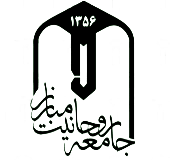
The Islamic Consultative Assembly, also called the Iranian Parliament, the Iranian Majles, is the national legislative body of Iran. The Parliament currently has 290 representatives, changed from the previous 272 seats since the 18 February 2000 election. The most recent election took place on 26 February 2016 and the new parliament was opened on 28 May 2016.

Ahmad Tavakkoli is an Iranian conservative populist politician, journalist and anti-corruption activist. He is currently managing-director of Alef news website and founder of the corruption watchdog, non-governmental organization Justice and Transparency Watch.
Parliamentary elections were held in Iran on 18 February 2000, with a second round on 5 May. The result was a solid victory for 2nd of Khordad Front and its allies, the reformist supporters of President Mohammad Khatami.
The Iranian Assembly of Experts election of 2006 was held on 15 December 2006. The Assembly of Experts is a Council of 86 mujtahids that elect the Supreme Leader, and oversee his actions. The members of the Assembly are elected every eight years directly by the people of Iran.

Legislative elections for Majlis of Iran were held on 14 March 2008, with a second round held on 25 April 2008. Conservatives loyal to President Mahmoud Ahmadinejad were considered the victors of the election, at least in part because "all the most prominent" reformist candidates were disqualified from running.

Parliamentary elections were held in Iran on 8 March 1996, with a second round on 19 April. The Combatant Clergy Association and its allies emerged as the largest bloc in the Majlis, winning 110 of the 270 seats.

Parliamentary elections were held in Iran on 13 March 1980, with a second round on 9 May. They were the first elections to the Majlis since the overthrow of the Shah, and were contested to a considerable degree on a party basis.

Parliamentary elections were held in Iran on 10 April 1992, with a second round on 8 May. The elections were the first parliamentary elections held in Iran since the death of Ayatollah Khomeini and during Ali Khamenei's leadership.

The parliamentary election for the 9th Islamic Consultative Assembly, or Majlis, were held in Iran on Friday, 2 March 2012 with a second round on 4 May 2012 in those 65 districts where no candidate received 25% or more of the votes cast. More than 5,000 candidates registered but more than a third were disqualified by the Guardian Council leaving about 3,400 candidates to run for the 290 seat representing the 31 provinces.
Parliamentary elections were held for the second time in Persia in 1909. The new Parliament convened on 19 November. The majority of the parliament was held by a some 53-seats coalition pioneered by Moderate Socialists Party.
Assembly of Experts election were held in Iran on 26 February 2016 to elect Assembly of Experts members. The 88 members of the Assembly of Experts, known as mujtahids, are directly elected. The elections had been planned for 2014, but were delayed by a year in order to hold them alongside the Islamic Consultative Assembly elections.
This is a summary of the electoral history of Hassan Rouhani, an Iranian politician who is currently President of Iran since 2013 and member of the Assembly of Experts from Tehran Province since 2000. He was previously member of the Islamic Consultative Assembly (1980-2000).

Elaheh Rastgou is an Iranian conservative-minded reformist politician who is currently an outgoing member of City Council of Tehran. She was formerly a Member of Parliament.
The second Iranian Assembly of Experts election was held on October 8, 1990 to elect all 83 members in 24 constituencies. The election was the first election of the assembly since Ayatollah Khomeini's death and election of Ali Khamenei as the new Supreme Leader. This election had the lowest turnout in the history of the Islamic Republic of Iran with 37.09% of the eligible voters participating.
The very first Iranian Assembly of Experts election was held on December 10, 1982 to elect all 82 members in 24 constituencies. 18,013,061 citizens voted in the elections, marking a 77.38% turnout. Out of 168 individuals registered to run, 146 (86.90%) were qualified allowed to do so.
Coalition of Imam's Line groups was an Iranian political alliance active in 1990s, consisting of Islamic radical leftist groups later emerging current reformists.
This is an overview of the Iranian legislative election, 2004 in Tehran, Rey, Shemiranat and Eslamshahr electoral district. Alliance of Builders of Islamic Iran was able to win 29 out of 30 seats in the constituency in the first round.
This is an overview of the Iranian legislative election, 2000 in Tehran, Rey, Shemiranat and Eslamshahr electoral district.
















